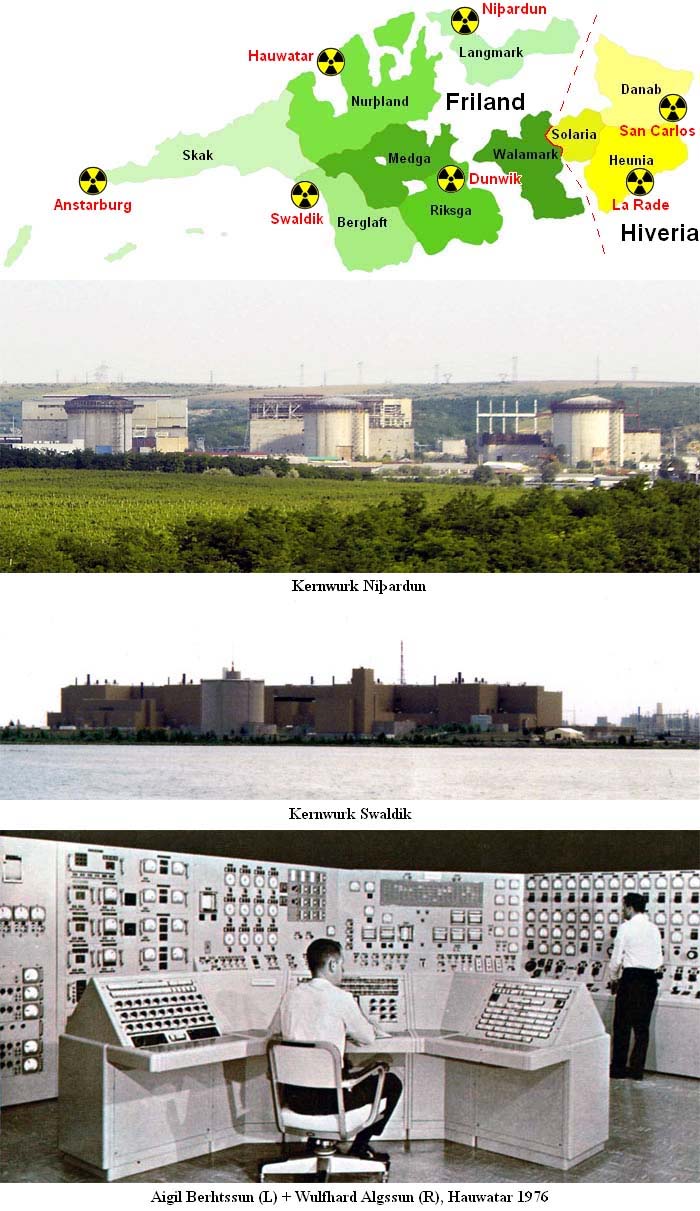  Nuclear programAll nuclear activities in Friland are conducted by the Council for Nuclear Energy ("Kernkraftrad"), a government company whose first priority is safety instead of making a profit. Energy companies, universities and other private parties may use the nuclear power plants, but the responsibility always remains with the government. Friland has the following nuclear facilities: Nuclear power plants There are four nuclear power plants ("kernwurkan"), each with two reactors: kernwurk Anstarburg (Skak), kernwurk Hauwatar (Nurŝland), kernwurk Niŝardun (Langmark) and kernwurk Swaldik (Berglaft). The plants are mainly used to generate electricity. All plants have CANDU reactors, which are very safe and can also work on multiple types of fuel, so that Friland is never fully dependent on one option.
Research reactor The university of Dunwik (Riksga) has a pebble-bed reactor (PBR). The reactor is mainly used for providing neutrons for scientific research and radioactive isotopes for medicine and industry.
Reprocessing and storage In Anstarburg (Skak) are a nuclear reprocessing site and an underground storage for nuclear waste.
Military use Friland doesn't own nuclear weapons. However, it does have the knowledge and capacity to produce these within a short time span. It also has all the necessary technology to build long-range missiles that can carry nuclear warheads, both ICBM's (InterContinental Ballistic Missile) and SLBM's (Submarine-Launched Ballistic Missile). The official position of Friland is that it will not produce nuclear weapons as long as it's not confronted with a nuclear threat, and that it will also never be the first to deploy these types of weapons. Nuclear installations:  History In 1970 both Friland and Hiveria signed the Non-Proliferation Treaty. The first Frilandic nuclear power plant was the one in Hauwatar. Its construction began in 1972 and was completed in 1976. On August 22, 1976, the nuclear reactor was started for the first time by Aigil Berhtssun and Wulfhard Algssun, at that time the driving forces behind the Frilandic nuclear program. To keep up with this, Hiveria also built a nuclear power plant in La Rade around the same time, which was completed a few months after the one in Hauwatar. Both plants had a boiling water reactor (BWR). In 1983 the Frilandic intelligence agency discovered that Hiveria was developing nuclear weapons. Friland then decided to do the same. Both countries thus acted in violation of international treaties and were therefore called to account by the UN. There were discussions, in which Friland promised to give up its nuclear weapons program if Hiveria would do the same. To everyone's surprise, the two archenemies reached an agreement, which continues to date. This so-called Frilandisk-Hiwerijaniska Kernsartrewiŝ / Convention Hivero-Frilandais sur les Armes Nucléaires ("Frilandic-Hiverian Nuclear Weapon Treaty") was signed on September 8, 1983. Hiveria Both Hiverian nuclear power plants are operated by private energy companies. Rules have been established for the use of nuclear energy, which are monitored by the Bureau de l'énergie atomique ("Bureau of atomic energy"). Hiveria has the following nuclear facilities: Nuclear power plants There are two nuclear power plants ("centrales nucléaires") with multiple reactors: centrale nucléaire de La Rade (Heunia) and centrale nucléaire de San Carlos (Danab). The plants are mainly used to generate electricity. The plant at La Rade has two older boiling water reactors (BWR) and one pressurized water reactor (PWR). The plant at San Carlos has two pressurized water reactors, one of which is used for research purposes.
Military use Hiveria doesn't own nuclear weapons. However, it does have the knowledge and capacity to produce these within a short time span. Though the country has announced not no have any concrete plans in that direction.  |